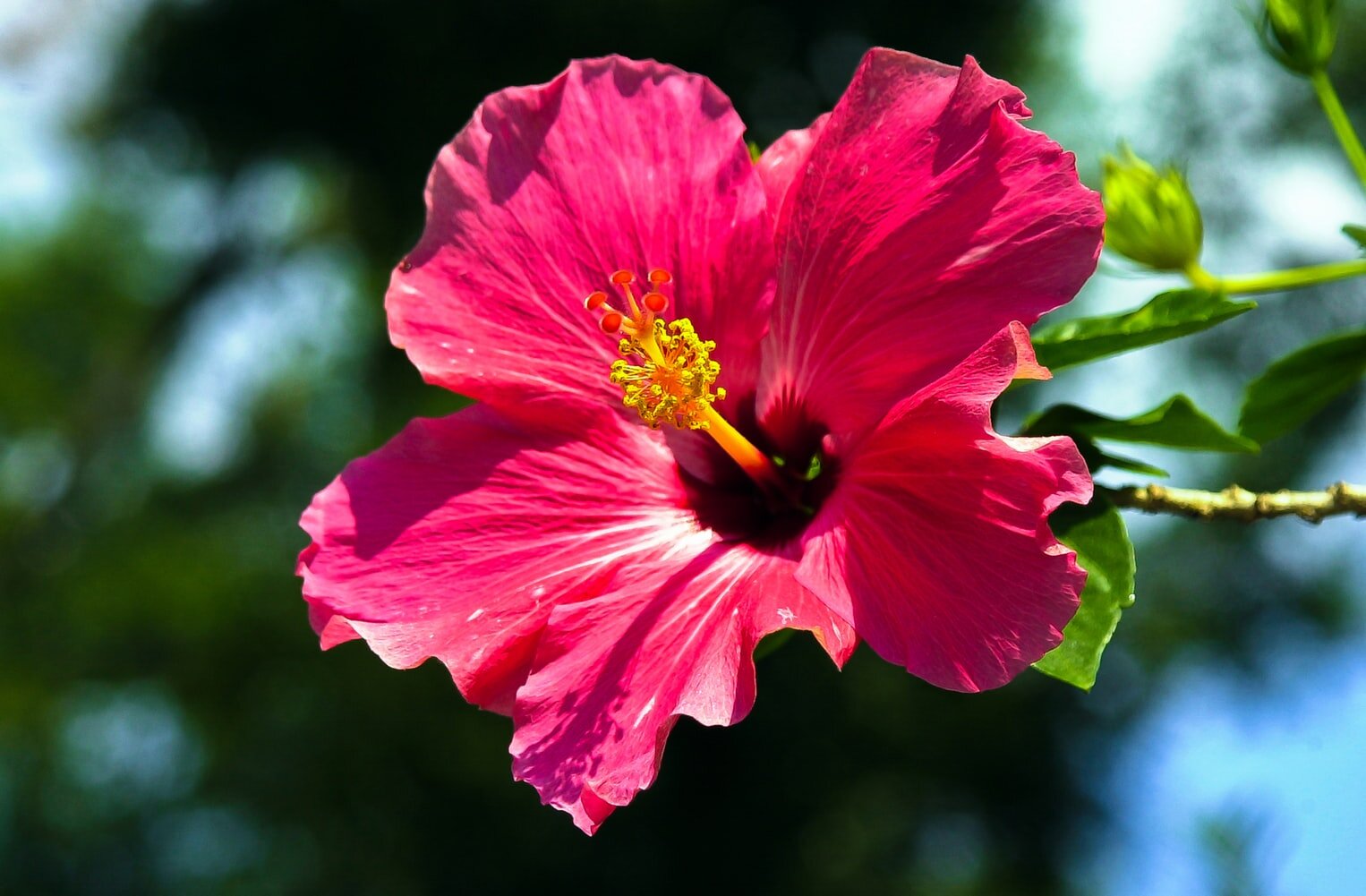Overwintering Common Subtropical Plants
In this article we cover the nitty gritty about overwintering your favourite tropical plants. If you are new to growing tropical plants and want to know more about them and their general growing requirements check out our other article: Bringing in the Tropics.
Click here to download a printable version of this information.
Tropical Hibiscus
Tropical Hibiscus do not tolerate below freezing temperatures, and will die back to the ground if they get too cold. Tropical hibiscus should be moved indoors once outside temperatures regularly begin to drop below 7 degrees Celsius. Before moving your plant indoors inspect it for insects. Keep an eye out for whitefly, as Hibiscus are prone this pest after being moved indoors. An insecticidal soap will treat a white fly infestation. After moving your Hibiscus indoors do not be alarmed if it’s drops all of its leaves. This is normal. The plant will soon produce new growth.
Make sure that it gets at least four hours of sunlight while indoors. Hibiscus overwinter best indoors when they have bright light and warm temperatures. Provide consistent moisture, but do not allow the plant to stand in water, which is a good practice for all houseplants. If your plant is growing in its original potting medium, it should be repotted in a good quality potting medium in the spring. At this time, prune back all leggy growth in late winter and begin fertilizing with a well-balanced fertilizer every two weeks.
Bougainvillea
Pictured: Bougainvillea
In September stop feeding Bougainvillea to prevent it growing too actively at the beginning of winter. Begin to reduce watering at this time as well. You need to bring it inside when daytime temperatures are six to eight degrees Celsius. Place it in a cool, light spot. A temperature between zero and twelve degrees Celsius is ideal.
It will lose leaves during winter dormancy. This will not damage the recovery of the plant. Water very sparingly during this time and there is no need to fertilize in the winter. You only need to prune your bougainvillea if you feel it is getting too large. February is the best time for pruning. It may mean less flowers on the pruned branches next summer.
As the temperatures start rising in March, you can slowly begin giving it more water. If you need to repot, choose a wide, heavy pot with good drainage. Always repot with sterile soil and add a soil release fertilizer, for example 14-14-14, at the same time.
Citrus
Depending on the hardiness of your citrus tree, plants may need to overwinter indoors or can be protected outdoors. If you do not have a frost hardy citrus tree (many of the dwarf varieties), then bring your plant indoors when nighttime temperatures start to dip down to about 7°C outside.
For the greatest chance of success with overwintering citrus outdoors, chose the hardiest citrus available, which is the variety of lemon called Meyer, or Improved Meyer. This variety is hardy to minus 5 Celsius, with fruit damage occurring at minus 3. To keep the tree warm enough when our winter temps go below zero, you can hang heating cables in the tree and wrap it in a row cover fabric like remay. In our experience, lemon trees grown outside through the winter have few pest issues than citrus grown indoors through the winter.
Mandevilla
Pictured: Mandevilla
Once night time temperatures begin to drop below 10 degrees Celsius it is time to protect your mandevilla. There are two options for overwintering mandevilla.
The first option is to bring it into your home. If you have enough space and a bright sunny window then move the container inside once the weather starts to cool down. Pune the vine back by about half before bringing it indoors. It will grow slowly during the winter months. You do not need to encourage growth at this time of year by fertilizing the plant, just water it when it begins to dry out.
Around February, prune the plant again and begin to fertilize it once a month. Mandevilla flowers on new growth so by pruning and fertilizing it, you' will give it an early start when you place it outside in May or June.
The second option for overwintering your mandevilla is to allow it go dormant. Keep the vine outside until nightime time temps drop to below 10 degrees Celsius, then move it into a cool garage or basement that stays about freezing. Overwintering it in a location around 10 degrees Celsius is ideal. If you are allowing your mandevilla to go dormant you should cut the plant back hard, to about 12 inches. Occasionally give it water so that it doesn’t dry out, but essentially leave it alone. Bring it inside when spring is just around the corner and let it start to grow. Then set it outside and enjoy this beautiful plant throughout the summer.
(Pictured: Calla lily)
Calla Lily
Calla lilies are tender perennials (Zantedeschia aethiopica is the hardiest calla lily and most likely to perennialize). Calla lily roots, or rhizomes, should by dug up in the fall and stored indoors over the winter. After a hard frost, cut off the foliage 1 to 2 inches above the soil surface. Carefully dig up the rhizomes. Do not cut or injure the rhizomes. Dry the rhizomes in a warm, dry location for 1 to 2 weeks. After drying, bury the rhizomes in vermiculite, sawdust, or peat moss. Store the rhizomes in a cool (10 to 15 degrees Celsius), dry location.
Pictured: Canna Lily
Canna Lily
Dig up and lift cannas in the fall and bring them inside for the winter. After the canna lily has been cut back, dig out the rhizome. To avoid damaging the rhizome dig about 1 foot away from the stem. Gently shake off the soil and cut off any foliage. Cure the rhizomes in a warm, dry place for a few days, then wrap them in newspaper and store in vermiculite, sawdust, or peat moss to prevent rot.
Store cannas in a dry place that is kept above 5 degrees Celsius. Check the rhizomes a couple of times over the winter to ensure they don’t dry out. If they are too dry, mist them with a bit of water.
When temperatures reach regularly reach above 10 degrees Celsius outdoors rhizomes can be planted outdoors. Ensure each rhizome has an eye. Leaves should appear shortly and blooms should appear in 10 to 12 weeks.
(Pictured: Musa bajoo)
Banana
To overwinter hardy bananas there are two main approaches:
Cut off the leaves once temperatures regularly drop below 10 degrees Celsius. Wrap the trunk with burlap and reemay, tying it with twin to keep in place. Mulch the crown of the plant heavily with straw or leaves.
Cut the plant down to 12 inches above the ground and cover with a thick layer of straw or leaf mulch.
In both approaches, covering the crown with a small waterproof hat (e.g. pie tin) helps decrease moisture entering the main stem and reduces risk of rot.
Bananas can also be overwintered as houseplants, which is the preferred method for red banana plants. Simply bring it inside before autumn temperatures start to drop and place it in as bright a window as you can find, and water it regularly. It’s likely that event with good treatment, the plant will probably decline. It should survive until spring, when it can be placed outside and be a happy plant again.
Pictured: Tibouchina
Tibouchina
Like most tropical plants, purple glory trees are very sensitive to frost, so plants should be brought indoors in the fall, before any subfreezing temperatures. Before moving the plant indoors, give it a few days in a shady spot to prepare it for dimmer indoor light. Before bringing indoors, inspect for any unseen pests. Overwintering plants need at least five hours of bright light every day and ideally temperatures between 15 and 20 degrees Celsius. A spot near a south- or west-facing window is ideal, but avoid planting it where there are drafts..
Tibouchina plants will not do dormant in the winter, but it’s growth will slow, and flowering will be reduced. Take care to turn the plant occasionally to keep it growing straight. Misting the plant will also help to maintain high humidity which discourages the growth of spider mites. Only water when soil feels dry to touch, and withhold fertilizer.








